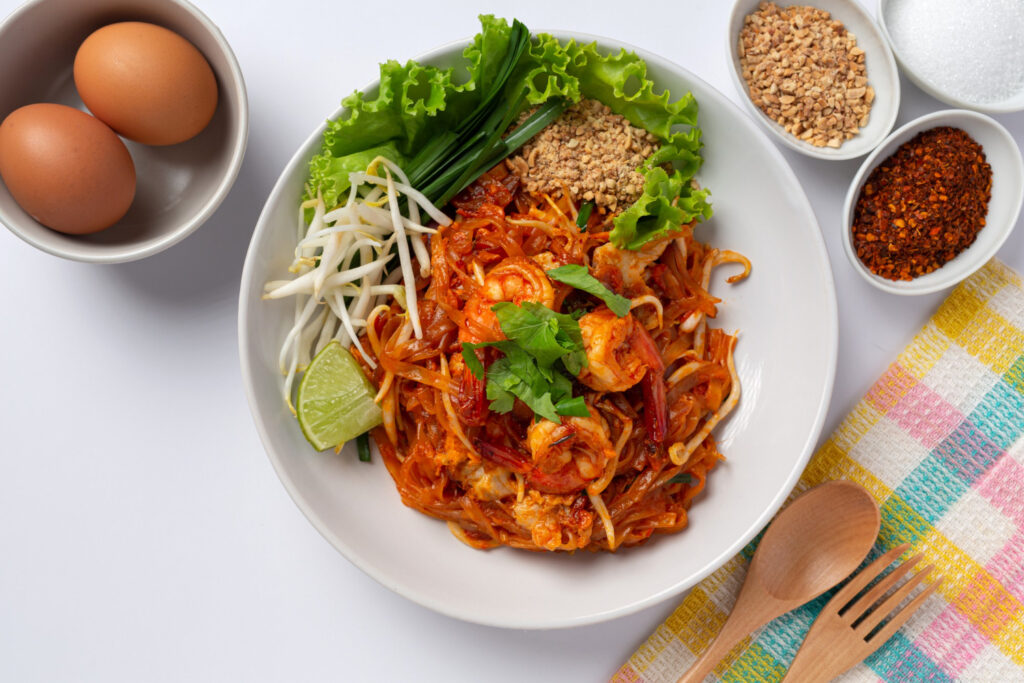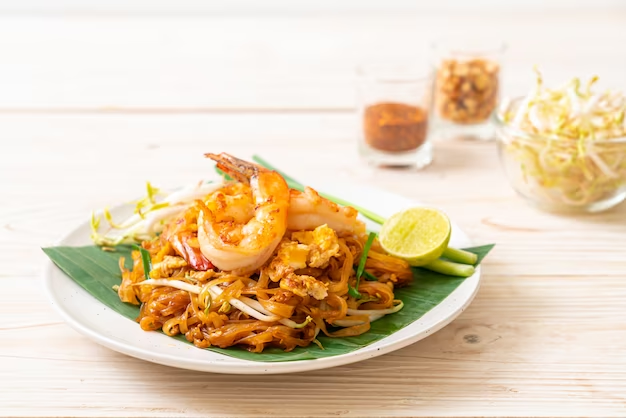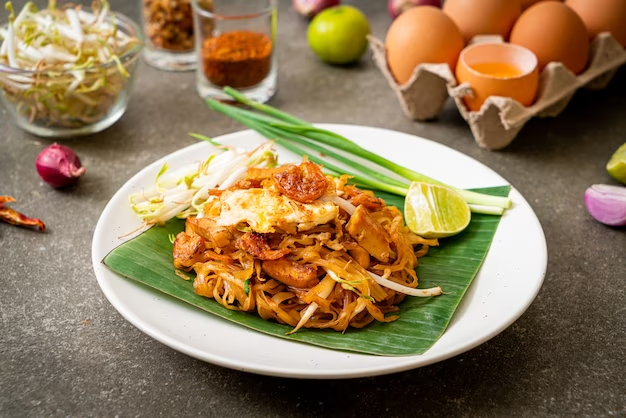When it comes to Thai cuisine, Pad Thai stands out as a beloved dish. But is Pad Thai healthy?
Many food enthusiasts and health-conscious individuals often wonder about the nutritional value of this popular Thai delicacy. In this article, we will delve into the question: “Is Pad Thai healthy?”
By examining its ingredients, nutritional composition, and potential health benefits. Join us as we unravel the truth behind the healthiness of Pad Thai and provide you with valuable insights to make informed dietary choices.
Maybe you concern: Pad See Ew vs Pad Thai – Everything You Need To Know
What is Pad Thai?

Pad Thai is a renowned and flavorful Thai dish that has gained global popularity. With a fascinating history, it originated in Thailand in the 1940s as a result of government efforts to promote national unity through a uniquely Thai-style noodle dish.
Traditional Pad Thai typically consists of stir-fried rice noodles, tofu, shrimp or chicken, bean sprouts, eggs, and a combination of tangy and savory sauces. The dish is commonly garnished with crushed peanuts, lime wedges, and fresh herbs.
Over time, regional adaptations have emerged, incorporating local ingredients and flavors. Some popular variations include vegetarian Pad Thai, seafood Pad Thai, and spicy Pad Thai. Each variation adds its own twist while staying true to the dish’s fundamental essence.
Is Pad Thai healthy?

Pad Thai can be a reasonably healthy dish, but it ultimately depends on the specific ingredients and cooking methods used.
Traditional Pad Thai includes nutritious elements like rice noodles, proteins (such as shrimp, chicken, or tofu), and vegetables. However, factors like high sodium content, excessive oil, and added sugars in sauces can affect its overall health.
To make it healthier, one can opt for lean protein, increase vegetable content, reduce sodium, and control portion sizes. Making mindful choices and modifications can help ensure that Pad Thai can be enjoyed as part of a balanced and nutritious diet.
How many calories is Pad Thai?
To provide an overview of the calorie content and macronutrient composition of Pad Thai, here is a table:
| Nutrient | Calories (per 1 cup/200g serving) |
| Calories | Approximately 350-500 |
| Carbohydrates | Around 45-55 grams |
| Protein | Approximately 10-15 grams |
| Fat | Roughly 10-15 grams |
It’s important to note that these values can vary depending on the specific ingredients and cooking methods used. The calorie content may be higher if additional oils or sauces are used.
What are the health benefits of Pad Thai ingredients?
Pad Thai ingredients can provide several health benefits due to the variety of nutritious components they contain.
- Rice noodles: Rice noodles used in Pad Thai are typically gluten-free and provide a source of complex carbohydrates. They offer energy and can be easier to digest for some individuals compared to wheat-based noodles.
- Protein (shrimp, chicken, tofu, etc.): Pad Thai often includes a protein source such as shrimp, chicken, tofu, or a combination. Protein is essential for building and repairing tissues, supporting immune function, and maintaining overall health.
- Eggs: Eggs are a good source of high-quality protein and contain essential nutrients such as vitamins A, D, E, and B vitamins. They provide satiety, support brain function, and contribute to muscle health.
- Vegetables (bean sprouts, green onions, carrots, etc.): Pad Thai incorporates various vegetables that offer a range of vitamins, minerals, and dietary fiber. Bean sprouts, for example, are low in calories and rich in vitamin C and folate. Green onions and carrots provide additional vitamins and antioxidants.
- Peanuts: Peanuts are often used as a garnish in Pad Thai, adding a delicious crunch and nutty flavor. They are a good source of healthy fats, protein, and fiber. Peanuts also provide essential minerals such as magnesium, phosphorus, and potassium.
- Tamarind sauce: Tamarind sauce is a key component of Pad Thai, offering a tangy and slightly sweet flavor. Tamarind is rich in antioxidants, vitamins, and minerals. It also contains compounds that may support digestive health.
Find out more: Is Pad Thai Gluten-Free? The Best Gluten Free Pad Thai Recipe
Tips and tricks to reduce calories and improve nutrition

Here are some tips and tricks to reduce calories and improve the nutrition of Pad Thai:
Lowering sodium content without sacrificing flavor
- Opt for reduced-sodium soy sauce or fish sauce to control sodium levels.
- Use fresh herbs, spices, and citrus juices (like lime) to enhance flavor without relying heavily on salt.
Alternative cooking methods and ingredient substitutions
- Instead of deep-frying ingredients, stir-fry them in a small amount of oil or use non-stick pans to reduce the overall fat content.
- Swap traditional rice noodles with healthier alternatives like zucchini noodles or shirataki noodles to reduce calorie and carbohydrate intake.
- Increase the proportion of vegetables and decrease the amount of noodles for a more balanced dish.
- Experiment with lean protein options such as grilled chicken, shrimp, or tofu to reduce saturated fat.
Add more vegetables and herbs
- Load up on colorful vegetables like bell peppers, broccoli, or snap peas to increase fiber and nutrient content.
- Incorporate fresh herbs like cilantro, basil, or mint for added flavor and antioxidants.
Control portion sizes
Be mindful of portion sizes to manage calorie intake. Opt for a smaller serving or share the dish with others.
How much is Pad Thai in Thailand?
The price of Pad Thai in Thailand can vary depending on several factors such as the location, type of establishment, and quality. On average, you can expect to find Pad Thai ranging from 30 to 100 Thai Baht (THB) per plate.
Street food vendors and local restaurants often offer more affordable options, while upscale or tourist-oriented establishments may charge higher prices. Prices can also vary based on additional ingredients, protein choices, or regional variations. It’s worth exploring different areas and trying Pad Thai from various places to find both delicious and reasonably priced options.
FAQs
Can I enjoy Pad Thai while following a keto or low-carb diet?
Regarding enjoying Pad Thai on a keto or low-carb diet:
- Opt for low-carb noodle alternatives: Replace traditional rice noodles with low-carb options like zucchini noodles (zoodles), shirataki noodles, or kelp noodles. These alternatives are lower in carbohydrates and can be used as substitutes while enjoying Pad Thai.
- Choose protein wisely: Select protein sources like shrimp, chicken, or tofu to keep the dish keto or low-carb friendly. Avoid proteins that are breaded or coated in sugary sauces.
- Control added sugars: Be cautious with the amount of sweet sauces like tamarind sauce or palm sugar used in the recipe. Consider using low-carb or sugar-free alternatives if needed.
- Increase healthy fats: Incorporate healthy fats into the dish, such as avocado slices, crushed peanuts, or drizzles of sesame oil. These additions can help provide satiety and contribute to the keto or low-carb diet.
Is Pad Thai a suitable choice for individuals with diabetes?
For individuals with diabetes, Pad Thai can be a suitable choice if consumed in moderation and with certain considerations:
- Portion control: Pay attention to portion sizes to manage carbohydrate intake. Opt for a smaller serving or share the dish with others to avoid excessive carbohydrate consumption.
- Choose whole grain or alternative noodles: Look for Pad Thai variations that use whole grain or alternative noodles, such as zucchini noodles or shirataki noodles, which have a lower glycemic index compared to traditional rice noodles.
- Balancing macronutrients: Consider the balance of carbohydrates, proteins, and fats in the dish. Including lean protein sources like chicken or shrimp, along with a higher proportion of vegetables, can help mitigate blood sugar spikes.
- Monitor sauces and condiments: Be mindful of the sauces and condiments used in Pad Thai, as some may contain added sugars. Opt for reduced-sugar or low-sugar options to manage blood sugar levels.
Are there any specific health benefits associated with the herbs used in Pad Thai?
Regarding the health benefits of the herbs used in Pad Thai:
- Cilantro: Cilantro is a herb often used in Pad Thai, known for its antioxidant properties and potential digestive benefits. It adds a fresh and vibrant flavor to the dish.
- Basil: Basil is another herb commonly used in Pad Thai, providing essential vitamins, minerals, and potential anti-inflammatory properties. It contributes a unique aroma and taste to the dish.
- Mint: Mint is occasionally added to Pad Thai, offering a refreshing flavor and potential digestive benefits. It may help soothe the stomach and provide a cooling sensation.
While the herbs used in Pad Thai contribute flavor and potential health benefits, their specific impact may vary depending on the quantity used in the dish.
What are the most common protein options in Pad Thai besides chicken and shrimp?
Besides chicken and shrimp, some common protein options in Pad Thai include:
- Tofu: Tofu is a popular protein choice in vegetarian or vegan versions of Pad Thai. It absorbs the flavors of the dish and provides a source of plant-based protein.
- Beef: Some variations of Pad Thai may include thinly sliced beef as the protein component. It adds a rich and savory flavor to the dish.
- Pork: In certain regions or adaptations of Pad Thai, pork may be used as the protein source. It offers a unique taste and texture to the dish.
- Combination: Pad Thai can also include a combination of proteins, such as chicken and shrimp, providing a variety of flavors and textures.
How can I estimate the calorie content of homemade Pad Thai?
To estimate the calorie content of homemade Pad Thai, follow these steps:
- Calculate the calorie content of individual ingredients: Look up the calorie values of each ingredient used in your Pad Thai recipe, considering both the cooked and raw forms.
- Measure ingredient quantities: Measure the quantities of each ingredient used in your recipe. This includes noodles, protein sources, vegetables, and sauces.
- Sum up the calories: Multiply the quantity of each ingredient by its calorie value per serving and sum up the results to get the total calorie content of your homemade Pad Thai.
Are there any specific vegetables that pair well with Pad Thai?
Several vegetables pair well with Pad Thai, enhancing both the flavor and nutritional value of the dish. Here are some specific vegetables that go well with Pad Thai:
- Bean Sprouts: Bean sprouts add a refreshing crunch and are commonly used as a topping for Pad Thai. They provide texture and a subtle nutty flavor.
- Bell Peppers: Bell peppers, whether red, yellow, or green, bring vibrant colors and a slightly sweet taste to the dish. They add a nice crunch and complement the other flavors.
- Carrots: Shredded or julienned carrots add a hint of natural sweetness and a vibrant color to Pad Thai. They contribute a satisfying texture and a boost of vitamins and fiber.
- Snap Peas: Snap peas lend a crisp and juicy element to Pad Thai. They provide a subtle sweetness and a pop of green color.
- Thai Basil: Thai basil is a specific variety of basil commonly used in Thai cuisine, including Pad Thai. Its distinct flavor adds an aromatic and herbal note to the dish.
What are some popular condiments or toppings to enhance the flavor of Pad Thai?
Popular condiments and toppings to enhance the flavor of Pad Thai include:
- Crushed Peanuts: Crushed peanuts add a delightful crunch and nutty flavor to Pad Thai. They also contribute to the dish’s texture.
- Lime Wedges: Squeezing fresh lime juice over Pad Thai adds a tangy and citrusy element that balances the flavors and brightens the dish.
- Chili Flakes or Sriracha: For those who enjoy a bit of heat, adding chili flakes or a drizzle of sriracha sauce can spice up the Pad Thai and provide a fiery kick.
Does the cooking method affect the nutritional value of Pad Thai?
Regarding the cooking method and nutritional value of Pad Thai:
The cooking method can affect the nutritional value of Pad Thai to some extent. Stir-frying Pad Thai generally requires a small amount of oil, which adds calories and fat content. However, the impact on the overall nutritional value will depend on factors such as the type and amount of oil used, as well as the cooking time.
Overcooking the vegetables can lead to nutrient loss, as some heat-sensitive vitamins and minerals can be degraded. However, stir-frying is a quick cooking method that helps retain the nutrients in the ingredients to a large extent.
To maximize the nutritional value, it is important to choose fresh and high-quality ingredients, minimize the use of excessive oil, and avoid overcooking the vegetables. Balancing the cooking time and temperature helps preserve the flavors and nutritional content of the dish.
How does the calorie content of Pad Thai compare to other popular international dishes?
The calorie content of Pad Thai can vary depending on the specific recipe and portion size. In comparison to other popular international dishes, Pad Thai tends to have a moderate calorie content.
However, it is important to note that calorie comparisons can differ based on specific ingredients, cooking methods, and portion sizes. Some international dishes may have higher calorie content due to factors such as heavy use of oils, creams, or fatty meats.
Can I find Pad Thai with organic or locally sourced ingredients in Thailand?
Yes, it is possible to find Pad Thai made with organic or locally sourced ingredients in Thailand. Here are some places where you may find such options:
- Organic Food Markets: Many cities in Thailand have dedicated organic food markets or farmers’ markets where you can find locally sourced and organic ingredients. These markets often have stalls or vendors selling fresh produce, including vegetables and herbs, which can be used to prepare Pad Thai.
- Farm-to-Table Restaurants: There are farm-to-table restaurants in Thailand that prioritize using locally sourced and organic ingredients in their dishes. These establishments work closely with local farmers and suppliers to ensure the quality and sustainability of their ingredients.
- Health Food Stores: Health food stores, especially in larger cities like Bangkok or Chiang Mai, often stock organic products, including noodles, sauces, and other ingredients used in making Pad Thai. These stores may carry local brands or imported organic options.
- Eco-Resorts or Sustainable Retreats: Some eco-resorts or sustainable retreats in Thailand focus on providing farm-to-table dining experiences. They grow their own organic produce or source ingredients from nearby farms, offering guests a chance to enjoy Pad Thai made with local and organic ingredients.
- Specialty Restaurants: Certain Thai restaurants specialize in serving organic or locally sourced cuisine. These establishments prioritize sustainability and work with local farmers and producers to create dishes like Pad Thai with high-quality ingredients.
Conclusion
Categorically, the question “Is Pad Thai healthy?” requires a nuanced answer. While Pad Thai can be a flavorful and nutritious choice, its health depends on various factors such as ingredient choices, portion sizes, and cooking methods.
By selecting lean proteins, increasing vegetable content, and controlling sodium and fat levels, Pad Thai can be enjoyed as part of a balanced diet. It is important to be mindful of portion sizes and make informed choices to ensure that Pad Thai aligns with individual health goals.
So, is Pad Thai healthy? With conscious decision-making, it can indeed be a tasty and health-conscious option to savor as part of a well-rounded meal plan.
Keep reading: What’s the Difference Between Pad Thai and Lo Mein?